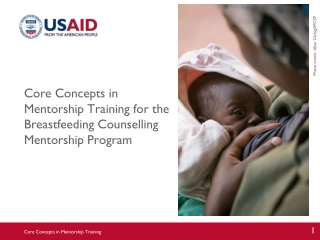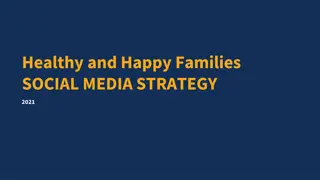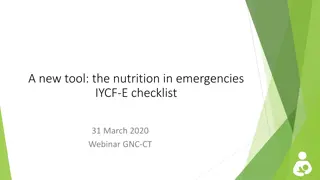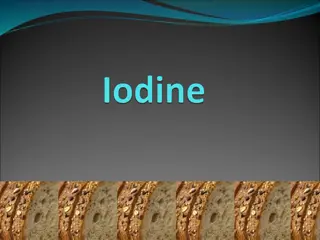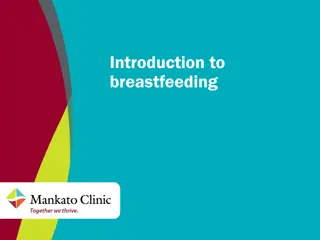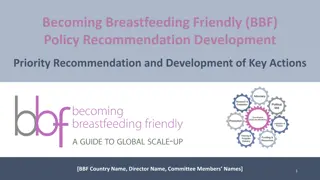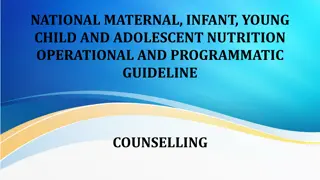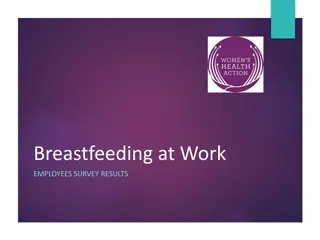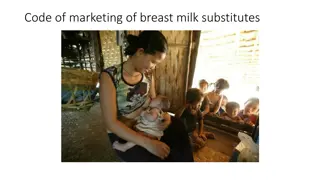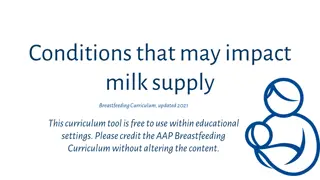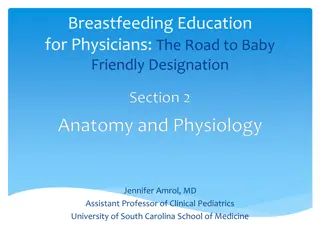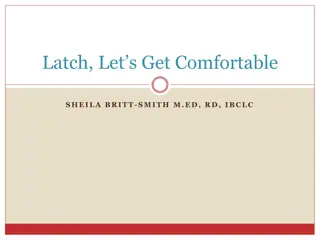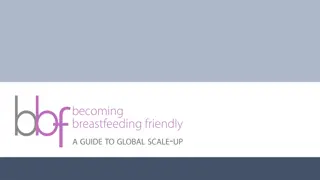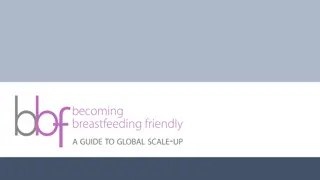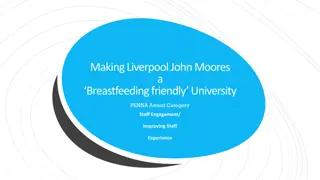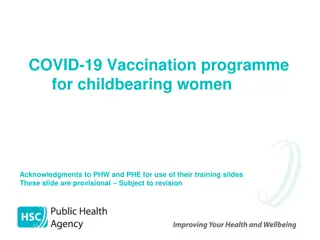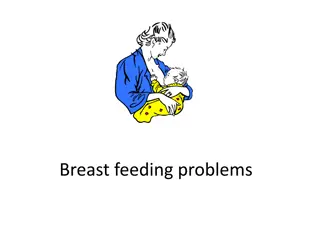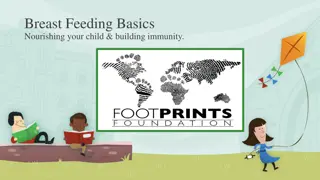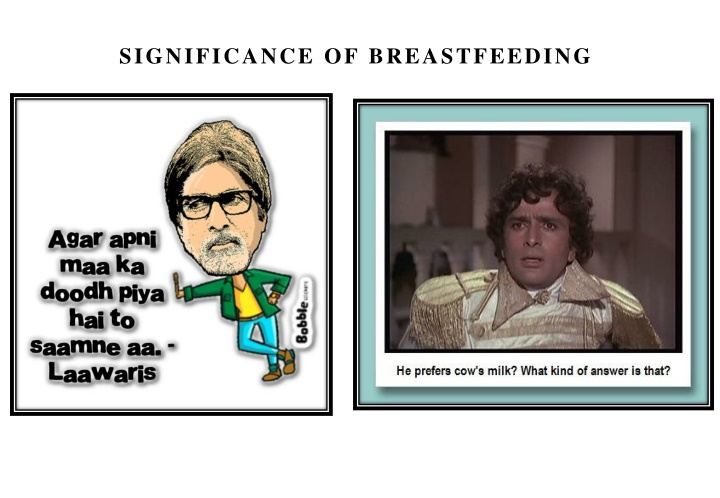
Importance of Breastfeeding for Infants and Mothers
Breastfeeding offers numerous benefits for both infants and mothers. It provides superior nutrition, immune protection, and promotes bonding and development for infants. For mothers, breastfeeding helps protect their health, reduce the risk of certain cancers, and aids in returning to pre-pregnancy weight. Additionally, breastfeeding has economic benefits for families by reducing medical care costs. Discover the powerful impact of breastfeeding on overall health and well-being.
Download Presentation

Please find below an Image/Link to download the presentation.
The content on the website is provided AS IS for your information and personal use only. It may not be sold, licensed, or shared on other websites without obtaining consent from the author. If you encounter any issues during the download, it is possible that the publisher has removed the file from their server.
You are allowed to download the files provided on this website for personal or commercial use, subject to the condition that they are used lawfully. All files are the property of their respective owners.
The content on the website is provided AS IS for your information and personal use only. It may not be sold, licensed, or shared on other websites without obtaining consent from the author.
E N D
Presentation Transcript
Benefits of breastfeeding for the infant Provides superior nutrition for optimum growth. Provides adequate water for hydration. Protects against infections and allergies. Promotes bonding and development.
Immune benefits of breast milk Antibodies of secretory IgA class Bind to microbes in baby's digestive tract and thereby prevent their attachment to the walls of the gut and their subsequent passage into the body's tissues. B12 binding protein Reduces amount of vitamin B12 which bacteria need in order to grow. Bifidus factor Promotes growth of Lactobacillusbifidus a harmless bacterium in baby's gut. Growth of such nonpathogenic bacteria helps to crowd out dangerous varieties. Fatty acids Disrupt membranes surrounding certain viruses and destroy them.
Immune benefits of breast milk Fibronectin Increase antimicrobial activity of macrophages, helps to repair tissues that have been damaged by immune reactions in baby's gut. Hormones and growth factors Stimulate baby's digestive tract to mature more quickly. Once the initially leaky membranes lining the gut mature, infants become les vulnerable to microorganisms. Interferon (IFN- ) Enhances antimicrobial activity of immune cells. Lactoferrin Binds to iron, a mineral many bacteria need to survive. By reducing the available amount of iron, lactoferrin thwarts/prevents growth of pathogenic bacteria.
Immune benefits of breast milk Lysozyme Kills bacteria by disrupting their cell walls. Mucins Adhere to bacteria and viruses, thus keeping such microorganisms from attaching to mucosal surfaces. Oligosaccharides Bind to microorganisms and bar them from attaching to mucosal surfaces.
Benefits of breastfeeding for the mother Protects mother s health helps reduces risk of uterine bleeding and helps the uterus to return to its previous size reduces risk of breast and ovarian cancer Helps delay a new pregnancy Helps a mother return to pre-pregnancy weight
Benefits of breastfeeding for the family Better health, nutrition, and well-being Economic benefits breastfeeding costs less than artificial feeding breastfeeding results in lower medical care costs
Benefits of breastfeeding for the hospital Warmer and calmer emotional environment No nurseries, more hospital space Fewer neonatal infections Less staff time needed Improved hospital image and prestige Fewer abandoned children Safer in emergencies
Colostrum Antibody rich - protects against infection White blood cells - clears meconium; helps prevent jaundice Purgative - helps intestine mature; prevents allergy, intolerance Growth factors - reduces severity of some infection (such as measles and diarrhoea) Vitamins A - prevents vitamin A-related eye diseases
Summary of differences between milks Human milk correct amount, easy to digest Animal milks too much, difficult to digest Infant formula partly corrected Protein enough essential fatty acids, lipase to digest lacks essential fatty acids, no lipase no lipase Fat enough extra needed may need extra Water Anti-infective properties present absent absent Adapted from: Breastfeeding counselling: A training course. Geneva, World Health Organization, 1993 (WHO/CDR/93.6).
Risks of artificial feeding Interferes with bonding More allergy and milk intolerance More diarrhoea and respiratory infections Increased risk of some chronic diseases Persistent diarrhoea Malnutrition Vitamin A deficiency Overweight Lower scores on intelligence tests More likely to die Mother May become pregnant sooner Increased risk of anaemia, ovarian and breast cancer Adapted from: Breastfeeding counselling: A training course. Geneva, World Health Organization, 1993 (WHO/CDR/93.6).
Intelligence quotient by type of feeding BF 12.9 points higher than FF Study in 9.5 year-olds 1996 BF 2 points higher than FF Study in 3-7 year-olds 1982 BF 8.3 points higher than FF Study in 7.5-8 year-olds 1992 BF 2.1 points higher than FF Study in 6 months to 2 year- olds 1988 References: BM 7.5 points higher than no BM Study in 7.5-8 year-olds 1992 Fergusson DM et al. Soc SciMed 1982 Morrow-Tlucak M et al. SocSciMed 1988 Lucas A et al. Lancet 1992 Riva Eet al. Acta Paediatr 1996 BF = breastfed FF = formula fed BM = breast milk
Breast milk composition differences (dynamic) Gestational age at birth (preterm and full term) Stage of lactation (colostrum and mature milk) During a feed (foremilk and hindmilk)
No water necessary Urine osmolarity (mOsm/l) Temperature C Relative Humidity % Country Argentina 20-39 60-80 105-199 India 27-42 10-60 66-1234 Jamaica 24-28 62-90 103-468 Peru (Normal osmolarity: 50-1400 mOsm/l) 24-30 45-96 30-544 Transparency 2.15
Breast milk in second year of life 100% % daily 80% needs 60% provided by 40% 500 ml 95% 45% breast 20% 38% 31% milk 0% Energy Protein Vitamin A Vitamin C From: Breastfeeding counselling: A training course. Geneva, World Health Organization, 1993 (WHO/CDR/93.6).
Protective effect of breastfeeding on infant morbidity
Risk of diarrhoea by feeding method for infants aged 0-2 months, Philippines 20 17.3 13.3 15 10 3.2 5 1.0 0 Breast milk only Breast milk & non-nutritious liquids Breast milk & nutritious supplements No breast milk Adapted from: Popkin BM, Adair L, Akin JS, Black R, et al. Breastfeeding and diarrheal morbidity. Pediatrics, 1990, 86(6): 874-882.
Percentage of babies bottle-fed and breastfed for the first 13 weeks that had diarrhoeal illness at various weeks of age during the first year, Scotland 25 22.3 22.4 Percent with diarrhoea 19.5 19.1 20 12.9 15 11.9 10 7.1 3.6 5 0 0-13 14-26 27-39 40-52 Incidence of diarrhoeal illness by age in weeks Bottle-fed Breastfed Adapted from: Howie PW, Forsyth JS, Ogston SA, Clark A, Florey CV. Protective effect of breastfeeding against infection. Br MedJ, 1990, 300: 11-15.
Percentage of infants 2-7 months of age reported as experiencing diarrhoea, by feeding category in the preceding month in the U.S. 11.4 12 10 8.5 8 6.4 5.4 Percent 6 Diarrhea 4.8 4 2 0 Breast milk only (100) High mixed (89-99) Middle Mixed (58-88) Low mixed (1-57) Formula only (0) Adapted from: Scariati PD, Grummer-Strawn LM, Fein SB. A longitudinal analysis of infant morbidity and the extent of breastfeeding in the United States. Pediatrics, 1997, 99(6).
Percentage of babies bottle-fed and breastfed for the first 13 weeks that had respiratory illness at various weeks of age during the first year,Scotland Percent with respiratory 54.1 60 47.1 45.5 50 42.4 40 38.9 36.2 40 illness 30 23.1 20 10 0 0-13 14-26 27-39 40-52 Incidence of respiratory illness by age in weeks Bottle-fed Breastfed Adapted from: Howie PW, Forsyth JS, Ogston SA, Clark A, Florey CV. Protective effect of breastfeeding against infection. Br MedJ, 1990, 300: 11-15.
Frequency of acute otitis media in relation to feeding pattern and age, Sweden Percent with acute otitis 20 20 14 15 13 media 10 7 6 5 4 5 1 0 1-3 4-7 8-12 months breastfed mixed fed weaned Adapted from: Aniansson G, Alm B, Andersson B, Hakansson A et al. A prospective coherent study on breast-feeding and otitis media in Swedish infants. Pediat Infect Dis J, 1994, 13: 183- 188.
Percentage of infants 2-7 months of age reported as experiencing ear infections, by feeding category in the preceding month in the U.S. 13.2 14 12 11.1 9.4 10 8 6.6 6.6 Percent Ear Infection 6 4 2 0 Breast milk only (100) High mixed (89-99) Middle mixed (58-88) Low mixed (1-57) Formula only (0) Adapted from: Scariati PD, Grummer-Strawn LM, Fein SB. A longitudinal analysis of infant morbidity and the extent of breastfeeding in the United States. Pediatrics, 1997, 99(6).
Protective effect of breastfeeding on infant mortality
Relative risks of death from diarrhoeal disease by age and breastfeeding category in Latin America 15.1 16 14 12 exclusive breastfeeding partial breastfeeding no breastfeeding 10 8 6 4.1 4 2.2 1 1 2 0 Diarrhoea 0-3 mo Diarrhoea 4-11 mo Adapted from: Betran AP, de Onis M, Lauer JA, Villar J. Ecological study of effect of breast feeding on infant mortality in Latin America. BMJ, 2001, 323: 1-5.
Relative risks of death from acute respiratory infections by age and breastfeeding category in Latin America 4.5 4 4 3.5 exclusive breastfeeding partial breastfeeding no breastfeeding 2.9 3 2.5 2.1 2 1.5 1 1 1 0.5 0 ARI 0-3 mo 4-11 mo Adapted from: Betran AP, de Onis M, Lauer JA, Villar J. Ecological study of effect of breast feeding on infant mortality in Latin America. BMJ, 2001, 323: 1-5.
Breastfeeding reduces the risk of chronic disease
Breastfeeding decreases the risk of allergic disorders a prospective birth cohort study Type of feeding Asthma Atopic dermatitis 24% Allergic rhinitis 6.5% Children exclusively breastfed 4 months or more 7.7% Children breastfed for a shorter period 12% 27% 9% Adapted from Kull I. et al. Breastfeeding and allergic diseases in infants - a prospective birth cohort study. Archives of Disease in Childhood 2002: 87:478-481.
Breastfeeding decreases the prevalence of obesity in childhood at age five and six years, Germany 5 4.5 4.5 3.8 4 Prevalence (%) 3.5 0 months 2 months 3-5 months 6-12 months 3 2.3 2.5 1.7 2 1.5 1 0.5 0 months breastfeeding Adapted from: von Kries R, Koletzko B, Sauerwald T et al. Breast feeding and obesity: cross sectional study. BMJ, 1999,319:147-150.
Breastfeeding has psychosocial and developmental benefits
Duration of breastfeeding associated with higher IQ scores in young adults, Denmark 108 106 106 104 < 1 months 2-3 months 4-6 months 7-9 months > 9 months 104 102.3 101.7 102 99.4 100 98 96 Duration of breastfeeding in months Adapted from: Mortensen EL, Michaelsen KF, Sanders SA, Reinisch JM. The association between duration of breastfeeding and adult intelligence. JAMA, 2002, 287: 2365-2371.
Breast cancer and breastfeeding: Analysis of data from 47 epidemiological studies in 30 countries 1.2 Relative risk of breast cancer 1 0.8 0.6 0.4 0.2 0 Lifetime duration of breastfeeding(years) 1 2 3 4 5 6 0 Adapted from: Beral V et al. (Collaborative group on hormonal factors in breast cancer). Breast cancer and breastfeeding: collaborative reanalysis of individual data from 47 epidemiological studies in 30 countries Lancet 2002; 360: 187-95.
Relationship between duration of breastfeeding and postpartum amenorrhoea (in months) Adapted from: Saadeh R, Benbouzid D. Breast-feeding and child spacing: importance of information collection to public health policy. Bulletin of the WHO, 1990, 68(5) 625-631.
Started in 1989, the milk bank at Lokmanya Tilak Municipal General Hospital, popularly known as Sion Hospital, is Asia s first and largest such bank. It gets donations from nearly 40 mothers every day and the milk benefits 3,000 babies every year.

